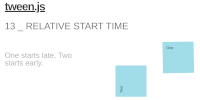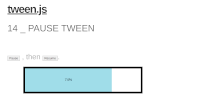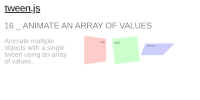
Security News
RubyGems.org Adds New Maintainer Role
RubyGems.org has added a new "maintainer" role that allows for publishing new versions of gems. This new permission type is aimed at improving security for gem owners and the service overall.
@tweenjs/tween.js
Advanced tools
Super simple, fast and easy to use tweening engine which incorporates optimised Robert Penner's equations.
@tweenjs/tween.js is a simple but powerful tweening engine for JavaScript. It allows you to create smooth animations by interpolating between values over time. This can be used for animating properties of objects, such as position, scale, rotation, and more.
Basic Tweening
This code demonstrates basic tweening where an object's properties (x and y coordinates) are animated from one state to another over a duration of 1000 milliseconds.
const TWEEN = require('@tweenjs/tween.js');
let coords = { x: 0, y: 0 };
let tween = new TWEEN.Tween(coords)
.to({ x: 100, y: 100 }, 1000)
.onUpdate(() => {
console.log(coords);
})
.start();
function animate(time) {
requestAnimationFrame(animate);
TWEEN.update(time);
}
requestAnimationFrame(animate);Easing Functions
This code demonstrates the use of easing functions to create more natural motion. The Quadratic.Out easing function is used to slow down the animation towards the end.
const TWEEN = require('@tweenjs/tween.js');
let coords = { x: 0, y: 0 };
let tween = new TWEEN.Tween(coords)
.to({ x: 100, y: 100 }, 1000)
.easing(TWEEN.Easing.Quadratic.Out)
.onUpdate(() => {
console.log(coords);
})
.start();
function animate(time) {
requestAnimationFrame(animate);
TWEEN.update(time);
}
requestAnimationFrame(animate);Chaining Tweens
This code demonstrates chaining tweens, where one tween starts after another finishes. The x coordinate is animated first, followed by the y coordinate.
const TWEEN = require('@tweenjs/tween.js');
let coords = { x: 0, y: 0 };
let tween1 = new TWEEN.Tween(coords)
.to({ x: 100 }, 1000);
let tween2 = new TWEEN.Tween(coords)
.to({ y: 100 }, 1000);
tween1.chain(tween2);
tween1.start();
function animate(time) {
requestAnimationFrame(animate);
TWEEN.update(time);
}
requestAnimationFrame(animate);GSAP (GreenSock Animation Platform) is a robust and high-performance JavaScript animation library. It offers more features and flexibility compared to @tweenjs/tween.js, including timeline management, advanced easing, and support for SVG animations.
Anime.js is a lightweight JavaScript animation library with a simple API. It supports various types of animations, including CSS properties, SVG, DOM attributes, and JavaScript objects. It is more feature-rich and versatile compared to @tweenjs/tween.js.
Popmotion is a functional, flexible JavaScript animation library. It provides a range of tools for creating animations and interactions, including physics-based animations. It offers more advanced features and flexibility compared to @tweenjs/tween.js.
JavaScript (TypeScript) tweening engine for easy animations, incorporating optimised Robert Penner's equations.
<script src="https://cdnjs.cloudflare.com/ajax/libs/tween.js/20.0.0/tween.umd.js"></script>
<div id="box"></div>
<style>
#box {
background-color: deeppink;
width: 100px;
height: 100px;
}
</style>
<script>
const box = document.getElementById('box') // Get the element we want to animate.
const coords = {x: 0, y: 0} // Start at (0, 0)
const tween = new TWEEN.Tween(coords, false) // Create a new tween that modifies 'coords'.
.to({x: 300, y: 200}, 1000) // Move to (300, 200) in 1 second.
.easing(TWEEN.Easing.Quadratic.InOut) // Use an easing function to make the animation smooth.
.onUpdate(() => {
// Called after tween.js updates 'coords'.
// Move 'box' to the position described by 'coords' with a CSS translation.
box.style.setProperty('transform', 'translate(' + coords.x + 'px, ' + coords.y + 'px)')
})
.start() // Start the tween immediately.
// Setup the animation loop.
function animate(time) {
tween.update(time)
requestAnimationFrame(animate)
}
requestAnimationFrame(animate)
</script>
Install from a content-delivery network (CDN) like in the above example.
From cdnjs:
<script src="https://cdnjs.cloudflare.com/ajax/libs/tween.js/20.0.0/tween.umd.js"></script>
Or from unpkg.com:
<script src="https://unpkg.com/@tweenjs/tween.js@^20.0.0/dist/tween.umd.js"></script>
Note that unpkg.com supports a semver version in the URL, where the ^ in the URL tells unpkg to give you the latest version 20.x.x.
Currently npm is required to build the project.
git clone https://github.com/tweenjs/tween.js
cd tween.js
npm install
npm run build
This will create some builds in the dist directory. There are currently two different builds of the library:
tween.umd.jstween.es.jsYou are now able to copy tween.umd.js into your project, then include it with a script tag, which will add TWEEN to the global scope,
<script src="path/to/tween.umd.js"></script>
or import TWEEN as a JavaScript module,
<script type="module">
import * as TWEEN from 'path/to/tween.es.js'
</script>
where path/to is replaced with the location where you placed the file.
npm install and import from node_modulesYou can add tween.js as an npm dependency:
npm install @tweenjs/tween.js
If you are using Node.js, Parcel, Webpack, Rollup, Vite, or another build tool, then you can now use the following to include tween.js:
import * as TWEEN from '@tweenjs/tween.js'
You can import from node_modules if you serve node_modules as part of your website, using an importmap script tag. First, assuming node_modules is at the root of your website, you can write an import map:
<script type="importmap">
{
"imports": {
"@tweenjs/tween.js": "/node_modules/@tweenjs/tween.js/dist/tween.es.js"
}
}
</script>
Now in any of your module scripts you can import it by its package name:
import * as TWEEN from '@tweenjs/tween.js'
px)

|
hello world (source) |

|
Bars (source) |

|
Black and red (source) |

|
Graphs (source) |

|
Simplest possible example (source) |

|
Video and time (source) |

|
Array interpolation (source) |

|
Dynamic to, object (source) |

|
Dynamic to, interpolation array (source) |

|
Dynamic to, large interpolation array (source) |

|
Repeat (source) |

|
Relative values (source) |

|
Yoyo (source) |

|
Stop all chained tweens (source) |

|
Custom functions (source) |

|
Relative start time (source) |

|
Pause tween (source) |

|
Complex properties (source) |

|
Animate an array of values (source) |
You need to install npm first--this comes with node.js, so install that one first. Then, cd to tween.js's (or wherever you cloned the repo) directory and run:
npm install
To run the tests run:
npm test
If you want to add any feature or change existing features, you must run the tests to make sure you didn't break anything else. Any pull request (PR) needs to have updated passing tests for feature changes (or new passing tests for new features or fixes) in src/tests.ts a PR to be accepted. See contributing for more information.
Maintainers: mikebolt, sole, Joe Pea (@trusktr).
FAQs
Simple and fast tweening engine with optimised Robert Penner's equations.
We found that @tweenjs/tween.js demonstrated a healthy version release cadence and project activity because the last version was released less than a year ago. It has 4 open source maintainers collaborating on the project.
Did you know?

Socket for GitHub automatically highlights issues in each pull request and monitors the health of all your open source dependencies. Discover the contents of your packages and block harmful activity before you install or update your dependencies.

Security News
RubyGems.org has added a new "maintainer" role that allows for publishing new versions of gems. This new permission type is aimed at improving security for gem owners and the service overall.

Security News
Node.js will be enforcing stricter semver-major PR policies a month before major releases to enhance stability and ensure reliable release candidates.

Security News
Research
Socket's threat research team has detected five malicious npm packages targeting Roblox developers, deploying malware to steal credentials and personal data.